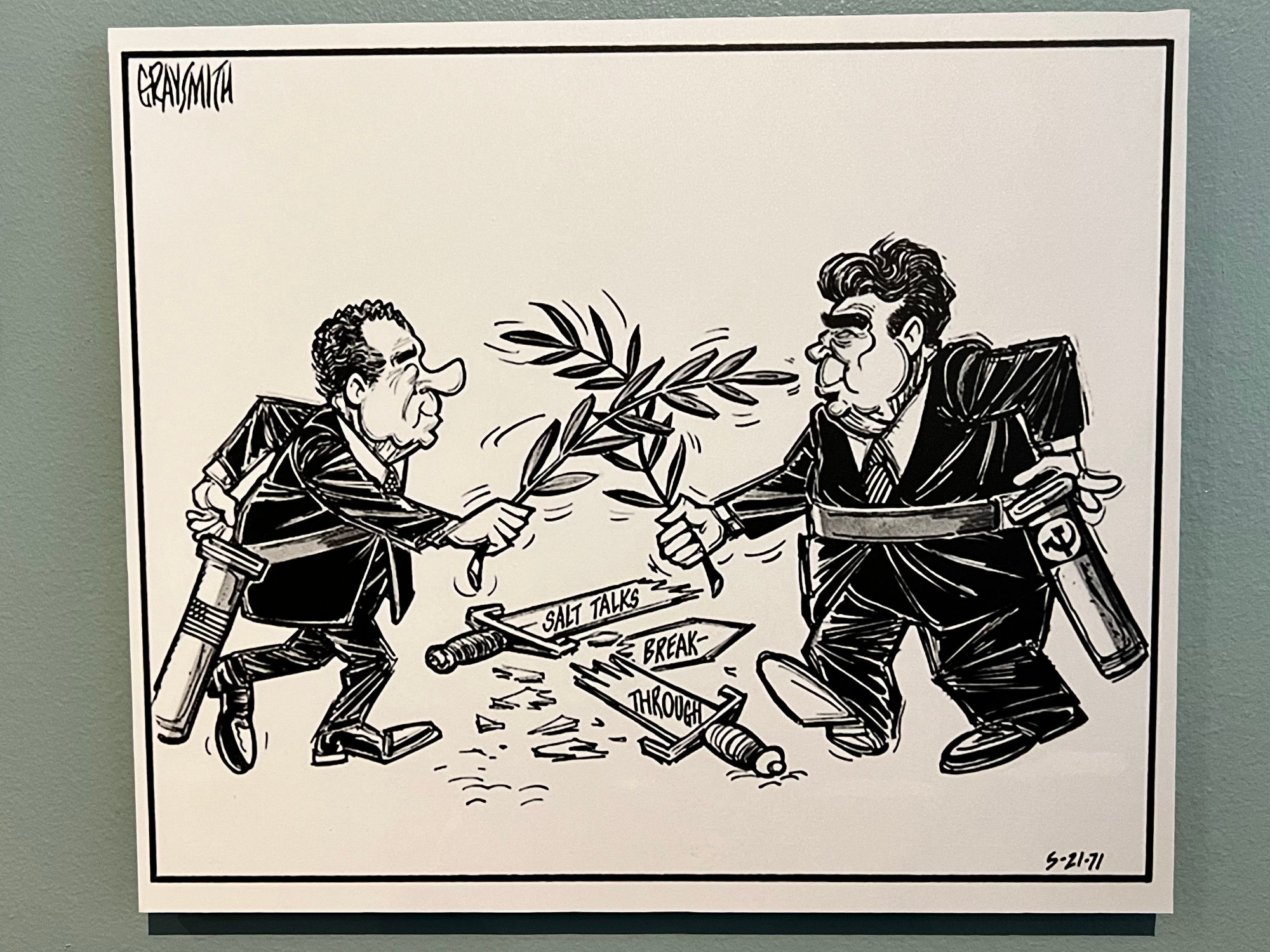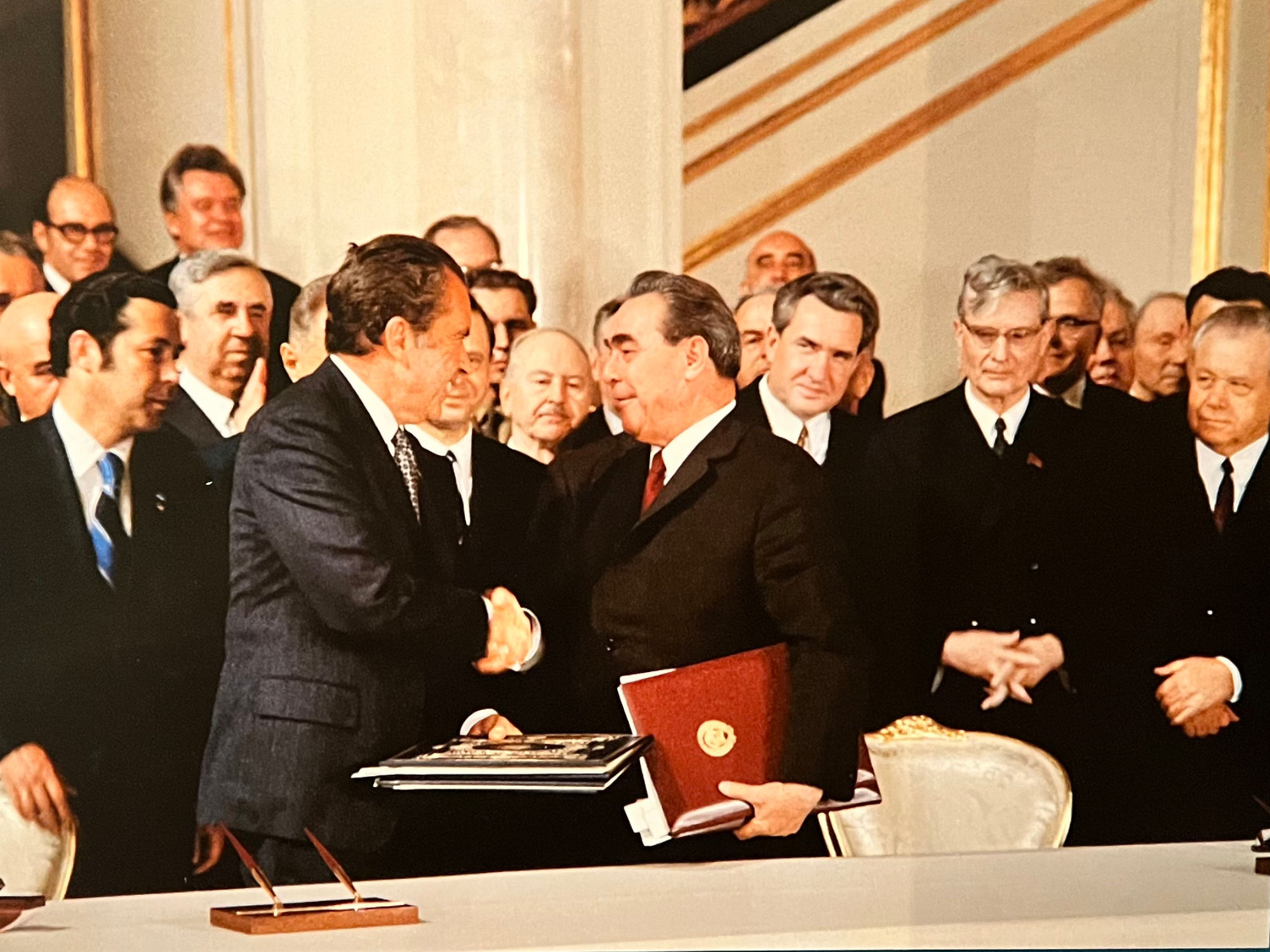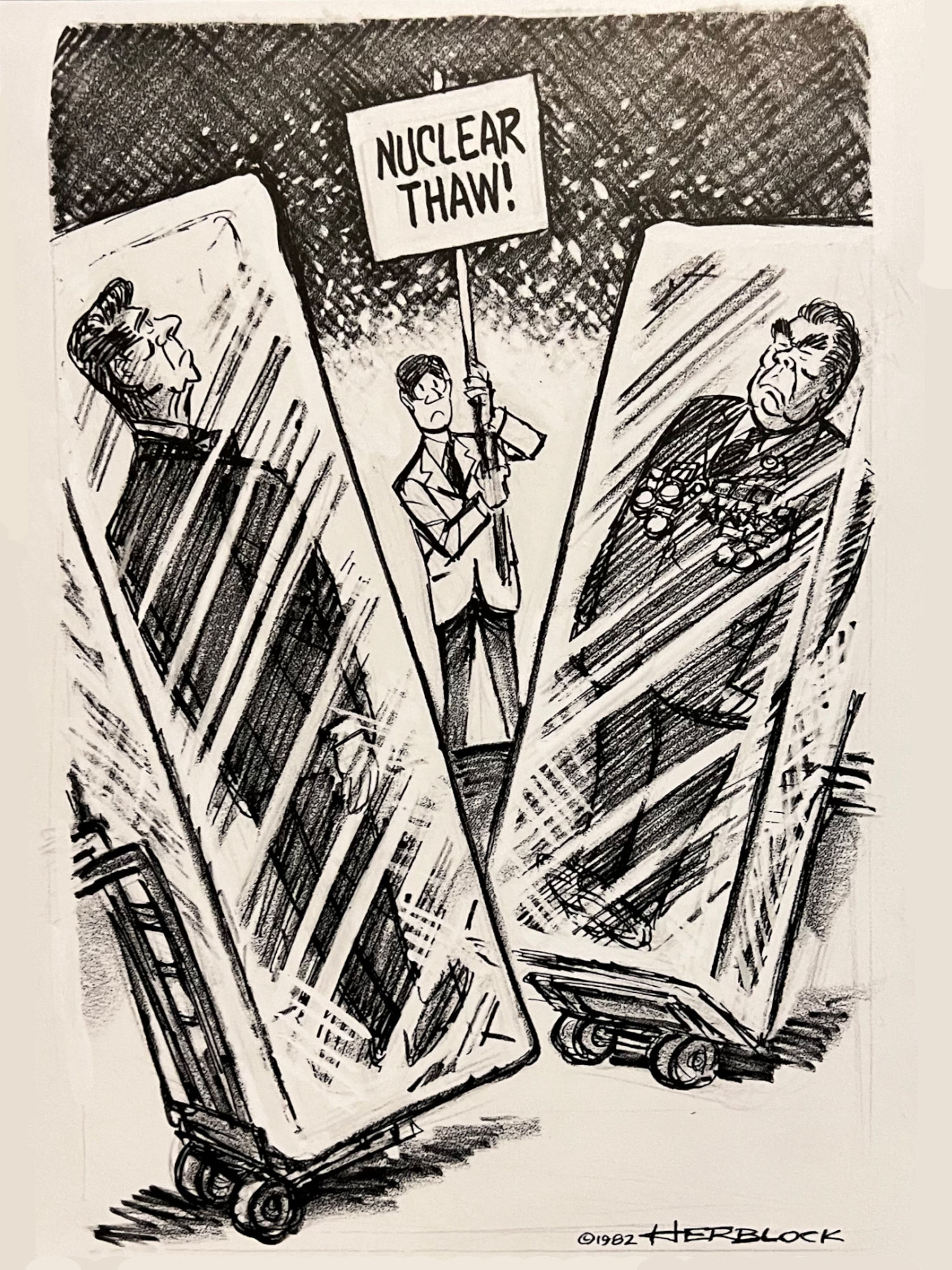Nine presidents of the United States bore the burden of leadership during the Cold War. During that same period, the Soviet Union was led by six different men. The relationships between these leaders as they pursued both their nation's interests and a path to peace helped define the Cold War.
The Soviet leader arrived in Washington on September 15, 1959, for a 13-day visit. Khrushchev embarked on a coast-to-coast tour of the United States before returning to Washington to meet with Eisenhower.
Eisenhower hosted Khrushchev at Camp David for two days of talks.
At the conclusion of their talks, on September 27th, the two leaders issued a joint statement.
They also "agreed that all outstanding international questions should be settled not by the application of force but by peaceful means through negotiation."
The meetings were applauded as creating a new "Spirit of Camp David," signaling a reduction in tension between the two nations.
After the conclusion of their meetings, Khrushchev invited Eisenhower to visit the Soviet Union during the spring of 1960.
But shortly after Soviet Air Defense Forces shot down an American U-2 spy plane on May 1, 1960, capturing pilot Gary Francis Powers, Khrushchev withdrew the invitation.
The Spirit of Camp David was dead.

- A favorite place to conduct international diplomacy, President Dwight D. Eisenhower Eisenhower stands with the Soviet Premier Nikita Khrushchev outside of Aspen Cabin at Camp David, the presidential retreat located in Maryland's Catoctin Mountain Park
DEFCON was developed during the Cold War to signal the threat level to the United States and the level of military readiness needed in response to the threat level.
DEFCON is divided into five levels. Although it is commonly thought that DEFCON 5 means a nuclear war is just minutes away, in fact the opposite is true.
DEFCON 5 indicates that the United States military is at a normal level of military readiness during peacetime.
DEFCON 1, on the other hand, means war is imminent.
| DEFCON: | ||
|---|---|---|
| DEFense Readiness CONdition | ||
| DEFCON 1 | CRITICAL | Major combat expected |
| DEFCON 2 | SEVERE | U.S. Military to be prepared for large scale military conflict |
| DEFCON 3 | SUBSTANTIAL | Increased force readiness and expansion of Air Force's deployable assets |
| DEFCON 4 | MODERATE | Increased intelligence watch and strengthened security measures |
| DEFCON 5 | LOW | Lowest state of readiness |
| COLD WAR | ||
During most of the Cold War, the United States was at DEFCON 4, meaning military readiness was just above normal.
Only twice has the level been raised to DEFCON 3, which puts the military on increased alert:
- The Yom Kippur War in 1973
[https://www.eatlife.net/nixon-library/nixon-middle-east.php] - The terrorist attacks of September 11, 2001.
DEFCON 2, which puts all or part of the military on heightened alert, has only been reached twice:
- The Cuban Missile Crisis in October 1962
- The start of the Gulf War in January 1991.
The United States has never moved to DEFCON 1.

The summit meeting convened just weeks after the disastrous U.S.-backed invasion of Cuba at the Bay of Pigs, which was intended to overthrow Cuba's communist dictator, Fidel Castro. Kennedy went to Vienna wanting to prove that the Soviets should not take the failure in Cuba as a sign of American weakness.
The meetings did not, however, go as Kennedy hoped. Shortly after the summit concluded, Kennedy confided his impressions to James Reston of the New York Times:
Khrushchev just beat the hell out of me. It was the worst thing in my life. He savaged me.
Khrushchev tested Kennedy's resolve 16 months later. In early October 1962, aerial surveillance revealed that the Soviets were getting ready to deploy ballistic missiles in Cuba, just 90 miles off the coast of the United States. Kennedy went on national TV to demand that the Soviets stop.
After a tense 13-day stand-off, during which the two powers seemed to be on the brink of nuclear war, the crisis ended. The Soviets agreed not to station nuclear missiles in Cuba and the United States agreed not to invade Cuba again and to remove missiles it had stationed in Turkey near the Soviet border.

- Soviet leader Nikita Khrushchev and President John F. Kennedy engaged in tense discussions in Vienna, Austria on June 3, 1961.

- Surrounded by interpreters and aides, Soviet leader Nikita Khrushchev forcefully drives home a point to President John F. Kennedy.

- This silver, gold, and niello inlay humidor was presented to President John F. Kennedy by USSR Premier Nikita Khrushchev during their June 4, 1961, meeting in Vienna, Austria.


- Pushinka (right) poses on the South Lawn of the White House with Charlie, another Kennedy family dog. Pushinka would later give birth to four puppies sired by Charlie.
Before the dog was delivered to the White House, the CIA checked her into the Walter Reed Army Medical Center for tests. The tests were looking for bugs - not fleas or ticks - but electronic bugs that might have been implanted in the pup to listen in on White House conversations. After a series of X-rays and other tests found the pooch was not a canine spy, she was delivered to the First Family.
Of course, the gift also carried a political meaning. The Soviets were very proud that they were the first nation to send a living creature - a dog named Strelka - into space and return it safely to earth. Pushinka was one of Strelka's puppies. So, the cute little dog was also a furry reminder to President Kennedy that the Soviets were ahead in the Space Race.
Tyav, tyav! [Woof, woof!]- Pushinka, 1961

- Pushinka, the dog given to the President and Mrs. Kennedy by Soviet leader Khrushchev, was issued her own Soviet passport for travel to the United States.

- October 14, 1962
There are 6 missile transporters and 3 launchers visible in this site on Mission 3113 (19 October). The launchers have not been placed in operational positions but preparation of these positions has been started. There are two missile-ready buildings. Nine oxidizer and 5 fuel trucks have been identified. Improvements noted on 19 October coverage causes us to revise the estimated date of full operational capability to 22 October. An emergency capability was probably reached on 17 October.
The next day, the CIA's analysts identified the site as a nuclear launch site for the medium range SS-4 missiles, thanks in part to a Soviet double agent named Oleg Penkovsky. The site was capable of launching nuclear missiles at the south-eastern half of the United States, and striking with speed that made detection and retaliation difficult.

The President assembled his top advisors (EXCOMM) and began weighing his options. President Kennedy requested airtime to directly address the American people on October 22, informing the public of increased military tension with the Soviet Union and the establishment of a naval blockade by the U.S. Navy around the island of Cuba.

- October 25, 1962
This site contains four launchers which have been placed in their operational positions. Fourteen oxidizer and 8 fuel vehicles have been identified. Six missile-ready buildings have been erected. At least seven missile transporters are present. The latest coverage available (Mission 3113 on 19 October) tends to confirm that it has full operational capability.
After Kennedy's Oval Office address, the nuclear readiness level for the Strategic Air Command was raised, for the first time in history, to DEFCON 2, one step away from war. The nation was gripped with fear that the long-dreaded nuclear war might finally erupt.
After several tense days, the threat of war passed. Soviet premier Nikita Khrushchev agreed to stop construction on the missile bases and pledged that the Soviet Union would not place nuclear weapons on Cuban territory. In return, President Kennedy secretly agreed to remove nuclear missiles the United States had installed in 1961 in Turkey, near its border with the Soviet Union.
President Kennedy traveled to Berlin to see for himself the wall that in August 1961, just seven months into his presidency, the communist East German government had begun to erect to end the flow of East Berliners to the West. Speaking in front of a huge, enthusiastic crowd in front of West Berlin's city hall, Kennedy uttered the famous words, "Ich bin ein Berliner" — I am a Berliner.

- Standing atop a platform, President John F. Kennedy peers across the Berlin Wall into East Berlin while visiting Germany in the summer of 1961.
Banned the testing of nuclear weapons in the atmosphere, outer space, and under water
- Kennedy and Khrushchev

- This luncheon menu and plate are from the June 25, 1967, meeting of the Hollybush Summit at Glassboro State College.

The United States and the Soviet Union cannot afford to go to war against each other, at any time or under any circumstances. Each side's vast military power makes war obsolete as an instrument of national policy.- Richard Nixon, Real Peace


When the Soviet Union began moving nuclear powered submarines capable of launching nuclear weapons into the base, the Nixon Administration saw this as a violation to the 1962 agreement that ended the Cuban Missile Crisis. Instead of broadcasting the imminent threat to the American people, President Nixon pursued back channel negotiations with the Soviets.

President Nixon decided not to publicly confront his Soviet counterpart, but instead first work to resolve the threat quietly through diplomatic channels. Although word of the Soviet's ongoing activity in Cuba was leaked to the media, and inadvertently confirmed by a Pentagon official, the Nixon administration downplayed the reports. Instead, a series of confidential toughly worded messages from Washington were conveyed to Moscow through the Soviet ambassador to the United States, Anatoly Dobrynin.

The Soviets initially acted as if the construction of the submarine bases was unimportant. When, however, National Security Advisor Henry Kissinger told Dobrynin that President Nixon saw the sub base as a violation of the Soviet pledge to keep nuclear weapons out of Cuba, the Soviets blinked. Although Moscow reaffirmed, in a diplomatic note, its 1962 pledge, it also stopped construction at Cienfuegos. The potential crisis passed, without igniting a worldwide panic.
President Nixon, just weeks after taking office, visited West Germany to affirm America's commitment to the people of that nation and to the people of West Berlin.
Making a four hour stop in West Berlin, Nixon directed his motorcade to the Wall. With thousands of West Berliners cheering him on, he climbed onto a viewing platform to gaze over into East Berlin. As the grim faced East German border guards focused in on him with their binoculars, Nixon waved back to them.

- President Nixon and Chancellor Kurt Kiesinger wave to a large and enthusiastic crowd in West Berlin, February 1969.
President Nixon sought to create a new structure of peace in which the United States and the Soviet Union would begin to reduce tensions and improve relations through the process of detente. Nixon also decided to end the two decades of what he called "angry isolation" between the United States and China.
Nixon's historic visit to China in February 1972, including his meetings with Chairman Mao Zedong and Premier Zhou Enlai, opened a new chapter in American foreign policy. Nixon's "triangular diplomacy" helped to disrupt the once-close relationship between China and the Soviet Union.
Nixon's May 1972 visit to the Soviet Union for a summit with General Secretary Leonid Brezhnev marked the first time an American president had met a Soviet leader in Moscow. The two leaders signed the first treaties of the Cold War to limit both strategic nuclear weapons and anti-ballistic missile systems.
Nixon and Brezhnev would meet twice more, in the United States in June 1973 and again in Moscow, in June 1974.
Although the Cold War would not end until the dissolution of the Soviet Union in 1991, many see Nixon's efforts to build a structure of peace as the beginning of the end of this long period of conflict.

- President Richard Nixon and Chinese leader Chairman Mao Zedong shake hands as they end more than 20 years of isolation between the two nations.

- In Moscow, on May 27, 1972, President Richard Nixon and Soviet Leader Leonid Brezhnev seal the the handshake the historic agreement to limit nuclear arms they just signed.
Froze the number of intercontinental ballistic missiles and submarine-launched ballistic missile
- Nixon and Brezhnev
Limited the deployment of anti-ballistic missile systems to two locations in each country
- Nixon and Brezhnev

- In the East Room of the White House on June 21, 1973, Soviet leader Leonid Brezhnev and President Richard Nixon sign an historic treaty to limit the use and stockpiling of nuclear arms.
The United States and the Soviet Union agreed to "prevent the development of situations capable of causing a dangerous exacerbation of their relations" that could lead to nuclear war
- Nixon and Brezhnev

In 1973, Richard Nixon hosted Leonid Brezhnev for their second summit meeting. During a visit to Camp David, Nixon presented Brezhnev with a new, dark blue Lincoln Continental, donated by the Ford Motor Company.
Brezhnev, a collector of luxury cars, couldn't wait to get behind the wheel to try out the latest addition to his collection, with the President riding shotgun.
Nixon would later recall:
The head of my Secret Service detail went pale as I climbed in and we took off down one of the narrow roads that run around the perimeter of Camp David... At one point there was a very steep slope with a sign at the top reading, "Slow, dangerous curve."
Brezhnev was driving more than 50 miles an hour as we approached the slope. I reached over and said, "Slow down, slow down," but he paid no attention. When we reached the bottom, there was a squeal of rubber as he slammed on the brakes and made the turn.
Brezhnev drove the car back to where they started, much to the relief of both the Secret Service and Brezhnev's security detail. As Nixon would later observe, "Diplomacy is not always an easy art."


- Gift of Leonid I. Brezhnev to President Richard Nixon and First Lady Pat Nixon, 1972

- Gift of Leonid I. Brezhnev to President Richard Nixon and First Lady Pat Nixon, 1972


- During First Lady Pat Nixon's Moscow trip, she visited the Bolshoi Theater School of Choreography on May 25, 1972, and received these ballet shoes from the director of the Bolshoi Academy.

- Gift of Leonid I. Brezhnev, General Secretary of the Communist Party of the Soviet Union, to First Lady Pat Nixon, 1973

- Gift of Leonid I. Brezhnev to President Richard Nixon and First Lady Pat Nixon, 1973
Further limited the number of intercontinental ballistic missiles and submarine- launched ballistic missiles
- Carter and Brezhnev

- Surrounded by American and Soviet government and military officials, President Jimmy Carter and Soviet leader Leonid Brezhnev signed a second Strategic Arms Limitation Treaty (SALT II) while meeting in Vienna, Austria on June 18, 1979.

The final, and perhaps most memorable, visit of an American president to the Berlin Wall took place on June 12, 1987. President Ronald Reagan, with the Berlin Wall and the Brandenburg Gate visible behind him, issued a ringing challenge to his Soviet counterpart: "Mr. Gorbachev, tear down this wall!"

- Against the dramatic backdrop of the Berlin Wall and the Brandenburg Gate, President Ronald Reagan urges Soviet leader Mikhail Gorbachev to "Tear down this wall", June 12th, 1987.

- President Ronald Reagan speaking at Moscow State University on May 30, 1988 against the backdrop of a giant bust of Vladimir Lenin, the founder of the Soviet Union.

- With the Statue of Liberty standing proudly behind them, President Ronald Reagan, Vice President George H.W. Bush, and Soviet leader Mikhail Gorbachev (second from left) on Governor's Island in New York Harbor, December 1988.


- These medallions were a gift from Mikhail Gorbachev for President and Mrs. Reagan's trip to Geneva, Switzerland.
Eliminated all intermediate and short-range nuclear ballistic missile, with verification
- Reagan and Gorbachev
Reduced the number of missile launchers and cut the number of nuclear warheads on "heavy" intercontinental ballistic missiles
- George H.W. Bush and Gorbachev

- On July 31, 1991, President George H.W. Bush and Soviet leader Mikhail Gorbachev signed the Strategic Arms Reduction Treaty (START) in the Kremlin in Moscow.

- Hungarian Prime Minister Miklos Nemeth presents President George H.W. Bush and Secretary of State James Baker with two pieces of barbed wire, parts of the 'Iron Curtain", that ran alongside the Hungarian-Austrian border.

- This plaque, commemorating the dismantling of the Iron Curtain along the Austro-Hungarian border, was presented to President George H.W. Bush.









